Search the Special Collections and Archives Portal
Search Results
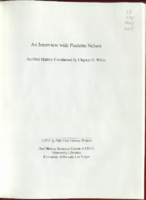
Transcript of interview with Paulette Nelson by Claytee D. White, March 2, 2009
Date
2009-03-02
Archival Collection
Description
Paulette R. Nelson's life in Las Vegas is a contrast of images. She recalls riding her horse across the wide-open desert, as well as embracing the technological changes that rapidly impacted the UNLV library. Paulette honed her life skills as farm girl growing up just south of Mandan, North Dakota. She attended North Dakota State University. A post-graduation summer as a volunteer in Kenya, sparked an interest in adventure and travel and she enlisted for four years in the U.S. Air Force. Rather than enter as an officer, she opted to be enlisted personnel so that she could receive technical training. In 1981, Paulette migrated to Las Vegas, where she had friends at Nellis Air Force Base. She worked at the Nevada Test Site for the next two years. Then, while looking for a new job so that she could pursue an engineering degree, she was offered a position in the UNLV library cataloging department. It was a career path change that she never regretted. She eventually became the Supervisor of the Architecture Studies Library; a position she held for nine years until her retirement Among the highlights of her career was being involved in the change to an electronic catalog system and being on the planning committee for Lied Library.
Text
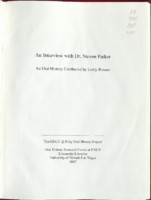
Transcript of interview with Dr. Steven Parker by Emily Powers, December 19, 2006
Date
2006-12-19
Archival Collection
Description
Dr. Steven Parker grew up and went to school in Connecticut. His parents were caterers and taught him a solid work ethic through example. His only sibling was finishing a post doctorate at Yale and had accepted a job at one of the Cal State schools when his life was tragically ended. Steven graduated from Assumption College in Massachusetts with a bachelor's in political science and got a scholarship to State University of New York at Albany. About hallway through his Master of Public Administration degree, the dean encouraged him to go on for his doctorate. He finished his PhD in 1971, and got a job at Western Illinois University which he started on September 15, 1971, the same day his son was born. Alter 8 years (and another child) in Illinois, Steve and his wife were ready to leave. He had attended a public administration conference in Baltimore in the spring of 1975, and was interviewed by Dina Titus and Tom Wright of UNLV. He had several other job offers, but UNLV looked like the best possibility, so he and his family moved to Las Vegas. Dr. Parker's title at UNLV was associate professor and department chair, although Dina Titus actually chaired the department his first semester here. He took over as chair in the spring of 1980. Steven started when Brock Dixon was interim chair, and has served under university presidents Leonard "Pat" Goodall, Bob Maxson, and Carol Harter. Today Dr. Parker teaches American Presidency and American government every semester, Natural Resource Policy and Political Corruption and Political Ethics once or twice a year, and occasionally teaches Urban Government. He also continues as the director of the University Forum Lecture Series, which was initiated by Tom Wright more than 23 years ago.
Text
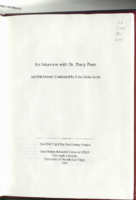
Transcript of interview with Dr. Percy Poon by Lisa Gioia-Acres, February 5, 2007
Date
2007-02-05
Archival Collection
Description
Dr. Percy Poon was born in Hong Kong in 1958, the oldest of four children. He attended Catholic school through junior high and high school, but decided to work after high school instead of going on to college. After working in banking and police forensics for a couple of years, he decided to continue his education. Percy studied economics at a university in Hong Kong, graduated at age 25, and then applied to Southwest Texas State for an MBA. Having earned his degree after only a year and a half, he applied and was accepted to a PhD program at Louisiana State. He interviewed for several jobs as he was approaching graduation, but decided to follow one of his professors, Mel Jameson, to UNLV. In August of 1989, Dr. Poon moved to Las Vegas to take on a visiting professorship, and the next year was promoted to tenure-track assistant professorship. In 1994, he met and married his wife, and they make their home in the southwest valley. Percy recalls the different styles and contributions of university presidents Robert Maxson and Carol Harter. His memories of first arriving in Las Vegas include the marvel of the volcano at the new Mirage Hotel, the oppressive heat, and the smaller size of the city. Currently, Dr. Percy is dean of the College of Business and Finance, and feels that the program is working towards competitiveness with other well-established university programs, such as UCLA or Arizona State. He feels that progress has been made in pushing for academic exams, but that increased funding will create better programs and opportunities. Dr. Poon became a U.S. citizen in 1998, and makes occasional visits to his family still living in Hong Kong. He and his wife socialize occasionally with colleagues and church acquaintances, and also entertain family members when they visit from Hong Kong.
Text
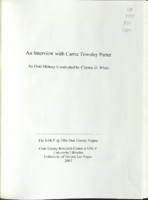
Transcript of interview with Carrie Townley Porter by Claytee D. White, February 7, 2006
Date
2006-02-07
Archival Collection
Description
Carrie Townley Porter, a 6th generation Texan, was born in Central Texas near present-day Fort Hood. Her father, a highway patrolman, was called into the Army Reserve in 1940 and spent some years moving around the country. At one point, his wife and children stayed in Belton, Texas tor three years because her father was transferred to places they couldn't go. Carrie finished high school in Austin, Texas, and attended two years at University of Texas in Austin. She left college to get married, and she and her geologist husband lived in Kansas, Oklahoma City, and Albuquerque. He took a job with the Atomic Energy Commission that required frequent trips to the Nevada Test Site, so the suggestion was made that they just move to Las Vegas. At this point they had three children with no reliable child care so Carrie became a housewife for a while. The Townleys lived a full and active life in Las Vegas and she eventually got hired as a substitute teacher. Carrie mostly subbed at Gibson Junior High School. She decided to finish her degree at Nevada Southern University (now UNLV) after her principal told her that if she could do that, he would have a job waiting for her. Several of the courses that Carrie took were Nevada history correspondence courses from UNR. These courses were prepared and graded by Dr. Russell Elliott. Carrie also fondly remembers two Nevada Southern history professors in particular, Dr. John Wright, whom she considered a mentor, and Rosemary Masick, who taught English history. After receiving her bachelor's, Carrie returned to teaching math at Gibson Jr. High. She started an archaeology club on her own and she and Russ Elliott started the first Trailblazer Club (junior history) in the state. She got students involved in the history of the Native Americans in the area and took them on field trips which gave them a chance to participate in a dig. Carrie has worked in Special Collections in the UNLV library as an archivist, with Sierra Pacific Power Company as a records analyst, and at Caesar's Tahoe as records administrator. She has also been very deeply involved with the Nevada Women's History Project since 1994. This group was responsible for the Sarah Winnemucca Statue Project, which placed a statue of this Native American in Washington, D.C., and a copy of it in the capitol building in Carson City. Today Carrie is doing a collaborative book on Helen J. Stewart with Sally Zanjani. She has done extensive research on Helen Stewart's life, and to this day makes "living history" presentations dressed as Helen J. Stewart. In addition to her history commitments, Carrie still holds onto her records management consulting firm, which she started in 1985.
Text
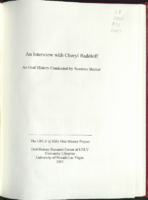
Transcript of interview with Cheryl Radeloff by Suzanne Becker, July 27, 2006
Date
2006-07-27
Archival Collection
Description
Dr. Cheryl Radeloff was born in Dayton, Ohio, and grew up in Beavercreek, Ohio, in the '60s. She graduated from Beavercreek High School and attended Bowling Green State University, where she earned a Bachelor of Arts degree in popular culture with a minor in women's studies. Cheryl's early work history included retail, an externship with the Children's Museum of Indianapolis, and a stint as a docent. After that she volunteered for Planned Parenthood of Miami Valley in Dayton, doing information gathering. She was offered a job working as an HIV educator /counselor for the organization, and learned to assist with basic procedures and do blood draws. Ms. Radeloff received her master's degree in sociology from the University of Toledo in 1996, and heard about a research position at UNLV. She contacted Dr. Maralee Mayberry and Dr. Peg Rees of the UNLV sociology department and was hired as a graduate assistant through Promise (Projects for Interdisciplinary and Multi-cultural Study in Education). Cheryl got involved in GSA and served as both a representative and as president (1999-2001) of that organization. She sat on many committees in this capacity and also counseled graduate students and listened to their suggestions and complaints. At the same time she was doing research for her dissertation and teaching classes. Cheryl received her PhD in 2004. The American Sociological Association Job Employment Fair in 2005 provided a forum in which her knowledge and experience as a social and health policy expert could be sought out by prospective institutions.
Text
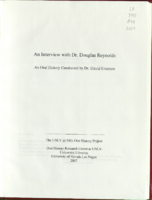
Transcript of interview with Dr. Douglas Reynolds by Dr. David Emerson, June 16, 2006
Date
2006-06-16
Archival Collection
Description
Professor Douglas Reynolds joined the engineering faculty in 1983. His credentials include a B.S. from Michigan State, M.S in mechanical engineering from Purdue, and a PhD in the same field, also from Purdue. Dr. Reynolds' work experience includes an assistant professorship at University of Texas a Austin (architectural engineering), associate professor in mechanical engineering at University of Pittsburgh, and a stint of industrial experience working for Caterpillar Tractor Company. He also worked as an acoustical consultant in Dallas, Texas. When interviewed at UNLV, Doug sensed that this was an opportunity to get in on the ground floor of a new engineering program and really have an impact on its development. He worked on the Engineering Advisory Committee and was given the task to justify the existence and growth of the engineering program at UNLV. He presented a report which documented the size and cost of the engineering building, and that report led to the existence of the building that can be found on campus today. With the building under construction, the engineering program itself needed accreditation with the American Board of Engineering and Technology. Dr Reynolds was responsible for documenting past, present, and future plans for the department courses and degrees. He also had to document a legitimate student graduation in order to apply tor accreditation. All this was accomplished in a short time, and the school received a very high evaluation. Dr. Reynolds' primary specialty is mechanical vibration and acoustics. He teaches machine design, kinematics and dynamics, and courses in mechanical vibration and acoustics. He wrote a textbook in the early 80's, "Engineering Principles of Acoustics." The updated revision will be completed soon, and he is also writing a new text entitled "Engineering Principles of Vibration". Douglas is chief U.S. delegate and chairman of the U.S. technical advisory group for ISO (International Standards Organization). He logs thousands of air miles every year on trips that are basically directed to research, bringing in research dollars, or are related to the standards work he does. His efforts on such a broad scale bring the UNLV engineering school national and worldwide exposure.
Text
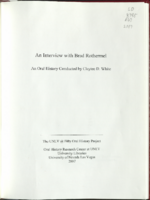
Transcript of interview with Brad Rothermel by Claytee D. White, July 31, 2006
Date
2006-07-31
Archival Collection
Description
Dr. Brad Rothermel gives a brief introduction to his childhood days in Monroe Center, Illinois. He was born into a family of educators, so it was natural that he completed a Bachelor's, and finally a doctorate. He attended Northern Illinois University in De Kalb for his undergraduate degree and the University of Illinois for his Master's and PhD. Dr. Rothermel's work history before arriving at UNLV in 1981 includes coaching in the Chicago Cubs organization and stints at Kansas State and West Virginia University as athletic director and business manager. He describes how he came to apply at UNLV and comments at length on the responsibilities of an athletic director. Brad goes into minute detail discussing the history of the athletic programs at UNLV. His memories of coaches, players, and memorable wins are as compelling as his descriptions of fundraising, an average day as athletic director, and outstanding figures in the UNLV sports scene. After retiring in 1990, Brad's association with UNLV sports did not end, but rather evolved into consulting, developing, and fundraising. He and his wife Suzanne continue to enjoy and appreciate their involvement with community, the university, and their children and grandchildren.
Text

Transcript of interview with Lee Scroggins by Claytee D. White, February 27, 2009
Date
2009-02-27
Archival Collection
Description
From a Montana childhood filled with memories of sub-zero winters to a whirlwind courtship and wedding to her husband of over three decades, Lee Scroggins brought an energy to all her administrative positions at UNLV. Lee and her family moved to Las Vegas in March 1980. Within a couple of months she was working at UNLV and except for a brief hiatus in the late 1980s she remained at the university until her retirement in 2009. She gives an account of her journey through the office staff levels she held. It began with a brief stint in the Education department (you couldn't rise a level until you had six months in one position); took her to the Business and Economics departments; the 1980s. After her hiatus from 1985 to 1988, she returned to UNLV to work in the Psychology department and eventually to the library. Her interview traverses the evolution of the administrative worker from a time without technologies that became the common tools. It was an era without many copy machines, no Xerox, or computers. In addition, Lee touches upon procedural changes that were inevitable as the university grew In retirement, Lee plans to "call her own shots" and enjoy life.
Text
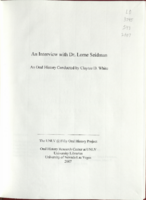
Transcript of interview with Dr. Lorne Seidman by Claytee D. White, November 14, 2006
Date
2006-11-14
Archival Collection
Description
Lawrence Seidman grew up in Cleveland, Ohio. He attended Culver Military Academy the first three years of high school, but graduated from Bay Village High School. He earned a bachelor's degree in business administration, and went on to law school at Case Western Reserve University. Lawrence and his wife moved to Chicago after he finished law school, where he worked in the First National Bank of Chicago doing estate planning and analysis. He wanted to try teaching, so he sent letters to many different schools. Ferris State College in Michigan gave him an interview, and he and his wife moved there for one academic year. The freezing cold winter convinced them that they did not want to stay in the Midwest, so Lawrence began writing letters to schools out west. UNR replied to the letter they received, saying they had no openings, but he might try Nevada Southern University in Las Vegas. The school was in the middle of changing its name to University of Nevada Las Vegas (UNLV). Lawrence flew out, interviewed with future colleagues, and accepted the job. He and his wife have lived in Vegas ever since 1969. Lawrence was the first full-time person hired to teach business law. He restructured the way the courses were developed and presented. A discipline officer was needed after the regents passed a new code of conduct and he was asked to take the position, which he did. Because the administrative or discipline officer reports to the president of the university, he got to know several of them rather well. Eventually, Lawrence became assistant general counsel, and also served as deputy attorney general for a while. His wife Janet pursued her degrees at UNLV, taught for about five years, and then worked at Children's Behavioral Services. Today they are both retired, and are enjoying traveling and working on their home. Lawrence occasionally teaches summer sessions at UNLV.
Text
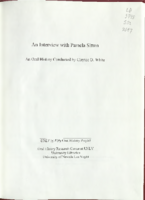
Transcript of interview with Pamela Sitton by Claytee D. White, February 27, 2009
Date
2009-02-27
Archival Collection
Description
Pamela Sitton’s childhood stories follow her construction worker father’s journey from one job to the next. She learned to adjust to a family move at a moment notice, to play in the back of a pickup truck and lived in a series of trailer homes. Finally in 1963, they moved to Las Vegas, where her father worked at the Test Site. For Pam, it was a chance to finish her schooling in one town. She attended the original Las Vegas High School and then UNLV, where she earned a degree in English literature. She recalls the Vegas of the 1960s for her unique perspective—a time of war protests, working a series of part-time jobs from cocktail waitress to post office worker, and her path to marriage in 1973. A position at UNLV’s library had been a dream job that she finally achieved when hired in 1974 as a member of the circulation staff. She held various positions throughout the library and remembers the various library buildings as a student and a professional.
Text
Pagination
Refine my results
Content Type
Creator or Contributor
Subject
Archival Collection
Digital Project
Resource Type
Year
Material Type
Place
Language
